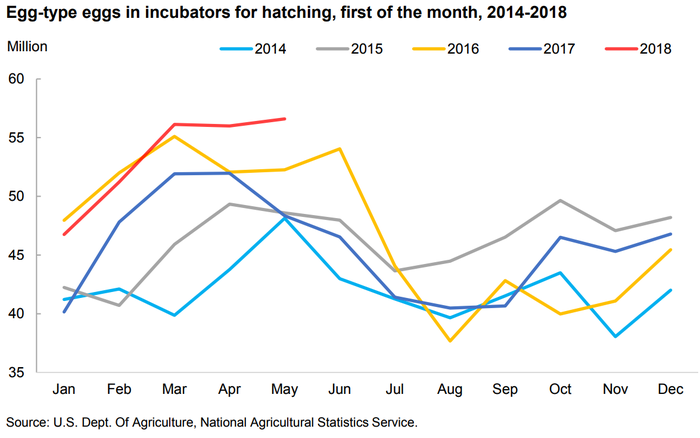Producers react to strong price trends since last September.

Producers have reacted to strong egg price trends since about last September by placing more fertile eggs in incubators for hatching, according to the U.S. Department of Agriculture’s latest “Livestock, Dairy & Poultry Outlook.”
“About four months after the chicks hatch, they typically enter the table egg laying flock. The last four months of data show 9% more layer chicks hatched than last year. As these chicks are integrated into laying flocks, some older layers will be retired,” USDA explained.

The 2018 production forecast was increased to 8.931 billion doz. to account for slightly more hatching egg production. Both the egg and broiler industries have been expanding layer inventories and increasing fertile egg production for this purpose, USDA noted.
April table egg production reached 637 million doz., about 1% higher than last year. The table egg layer inventory on May 1 was up about 2% from a year earlier, while egg production per layer was 1% lower.
April exports higher
April exports of eggs and egg products were 30 million doz. (shell-egg equivalent), nearly 5% above last year. USDA said export growth was led by 3.4 million doz. more eggs and products shipped to Canada, most of which were shell eggs.
Exports were up 2.8 million doz. to Japan and up nearly 1 million doz. to Hong Kong. USDA said the increased shipments to Japan were egg products, while those to Hong Kong were shell eggs.
Substantially lower exports to the United Arab Emirates and South Korea weighed down export growth, with shipments those countries down 2.6 million and 1.9 million doz., respectively, USDA reported.
Imports of eggs and egg products to the U.S. in April were 1.2 million doz., about 71% below last year due almost entirely to the absence of imports from the Netherlands. The 2018 and 2019 import forecasts were reduced to 28 million and 35 million doz., respectively.
Product stocks trending down
Stocks of egg products have been trending down, reaching 62 million doz. (shell-egg equivalent) as of April 30.
“Incentives to sell stocks have been strong, given strong egg price trends,” USDA said. “Historically high stock levels prevailed after the egg industry recovered from avian influenza in 2015, but stocks have declined over 50% since February 2017.”
USDA said stock levels in the coming months should begin to accumulate again as egg prices are expected to be moderate. Summer months typically have lower egg prices and the greatest stock increases. Projected stocks for the end of 2018 and 2019 were reduced to 90 million doz. for both years.
Egg prices at normal seasonal levels
Wholesale egg prices (large grade A eggs, New York) were stable in the second half of May after a sharp post-Easter decline. USDA said May’s daily midpoint average of 98 cents/doz. concluded five months of multi-year high prices and was fairly representative of the years 2012-14.
Prices prior to the 2015 outbreak of highly pathogenic avian influenza were considerably less volatile than in the period since then, USDA noted.
“Going forward, prices are expected to drift upwards and then increase more significantly in the fall due to normal seasonal trends,” the agency said.
USDA reduced its second-quarter price projection to $1.18-1.21/doz., with 2018 prices projected to average $1.35-1.40 cents/doz.
About the Author(s)
You May Also Like



